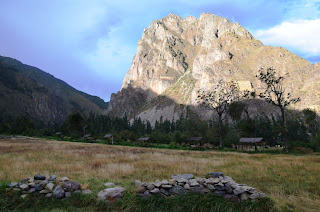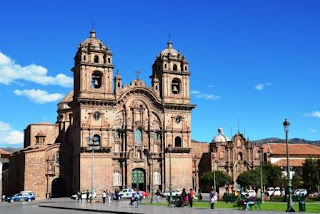We had an extra day in Cuzco before we were continuing our Peruvian trip. In the end we decided to spend this day out of Cuzco and instead visit the Sacred Valley. We found a very cheap bus tour that would take us around to some of the most interesting places in the valley. We were first not sure whether we were being cheated such that there wouldn't be any bus tour at all since it was so cheap, but then we found out that the ticket didn't include any entrance fees to any of the sites along the tour. These entrance fees cost three times as much as the bus tour, but it was still well worth it.
If we would have stayed in Cuzco, we would have visited the "Sexy Woman" (Sacsayhuaman). Unfortunately, we missed this now, but the bus did pass by the old ruins so at least we got a quick look.
We saw many football pitches all over Peru, here is one in the Sacred valley. It would have been interesting to try and play at this high altitude. When you just walk around where it is flat, you don't feel any difference from how it is at sea level. However, the heart starts pounding and the breathing speeds up as soon as you start running or walk up steep hills or stairs.
The altitude definitely makes a difference. There are even FIFA regulations for at how high altitudes World Cup qualifying matches can be played. The limit is at 3000 m, which is a bit lower than Cuzco. The home stadium of the Peruvian national team is in Lima, at sea level, so there are no problems. The home stadium of the national team of Bolivia (Peru's neighbour), on the other hand, is in La Paz, which is located close to Lake Titicaca in the Bolivian mountains at an elevation of about 3650 m above sea level. This is above the limit, but FIFA gave a special exemption for the stadium. The high altitude have helped the Bolivians to some really good results in history. In 1993 they became the first team to ever beat Brazil in a World Cup qualification match and in 2009 they beat Argentina 6-1, which was Argentina's worst defeat in 60 years.
The second stop was in a small market, where they sold a lot of traditional Peruvian souvenirs. For some reason I never bought a warm hat in Brazil and never brought one over either, instead I bought one here, so that I would be prepared for the colder parts of the trip that were still to come.
Serpentine roads up to the Pisaq ruins.
Terraces in front of the Pisaq ruins.
Some of the Pisaq ruins.
Football pitch in a tiny community, visible from the ruins.
We continued to a market in Pisaq. The market was really big and they had a lot of things, but unfortunately we didn't have much time. That's the disadvantage with these bus tours: you don't have much time anywhere. It's always 30 min here 40 min there, but on the other hand, you do get to see a lot of different things. We then continued to have lunch in Urubamba, where this parrot was sitting just outside the restaurant.
These ruins are in Ollantaytambo.
The Incas moved these massive stone blocks from across the valley and placed them perfectly next to each other. The fact that they managed to move so enormous stone blocks quite large distances might not be as impressive as what the Egyptians did with the pyramids, but it's still really impressive. I find it even more impressive how they shaped the blocks to perfectly fit together. We will see more of this later, in other old Inca ruins.
The ruins on the right are located a bit up on a mountain in Ollantaytambo. They are situated in the corner of some valleys, such that it is very often windy and cold up there. This might first sound strange, but they were not used as temples or as a military post, but as a big storage houses or as a huge fridge. This way the Incas could keep the food fresh for much longer. To the left in picture you can also see a big face in the rock. I think I heard that it is almost 150 m from top till bottom. The face was carved out of the mountain by the Incas.
The face you can see here in profile is supposedly natural. The time of year when the sun comes up in a certain part of the face marks the best time to sow new crops.
We found plenty of cacti with many fruits in the ruins, but we didn't yet know what we could do with them...
The Incas formed channels in the stone in order to guide the water to where they wanted it, here into a water temple.
I saw this mountain from the bus close to Ollantaytambo. I think it really looks like an octopus.
The last stop before coming back to Cuzco was Chinchero. There was an old church and many people selling different Peruvian clothes. There seemed to be really good things here for a quite low price, possibly due to that it was a very small community or thanks to that it was getting rather late and it was the last chance for the vendors to sell their goods for the day. Either way, we would have liked to stay longer, but we had to get back on the bus.
It's amazing how many stars you can see in places like this where you are far from cities and lights and also at a high altitude. I heard some people say that they finally understood why it's called the Milky Way, since you really can see that most stars are along one line.























































